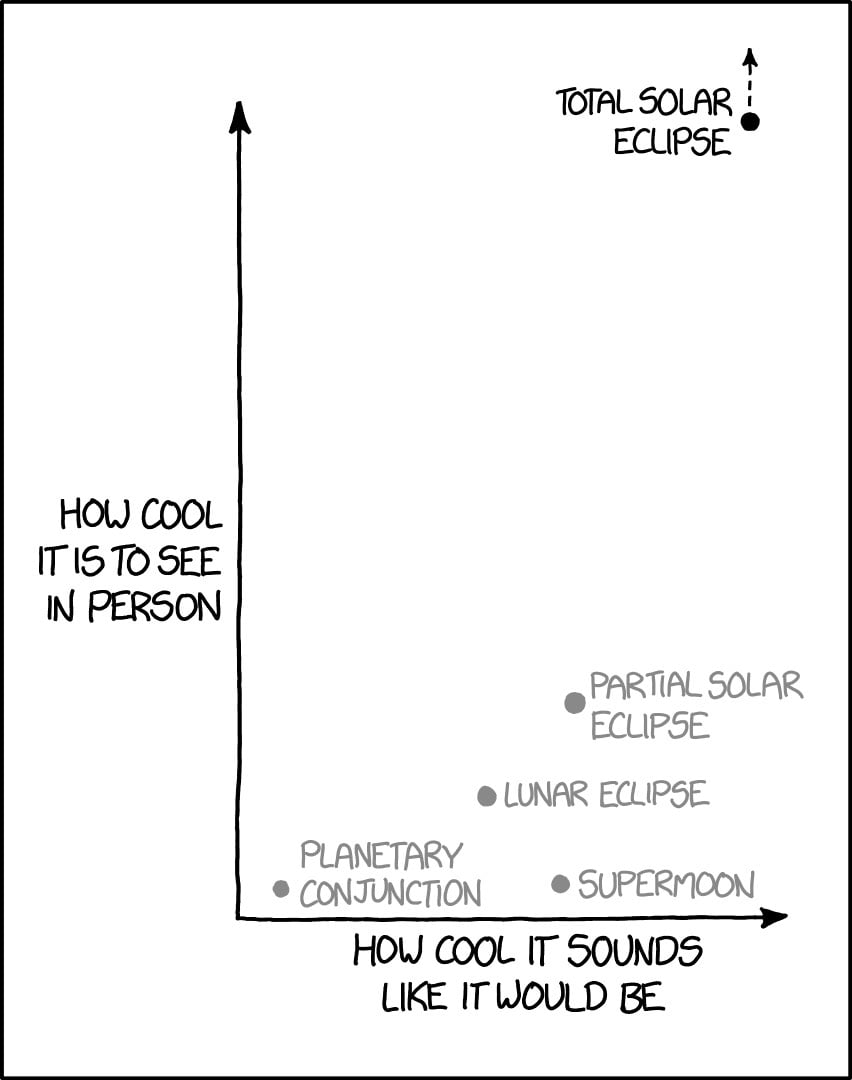What witnessing a total eclipse is like
In an essay from 1982 about her seeing a total solar eclipse in Washington (recently republished in this collection), Pulitzer Prize winner Annie Dillard puts into words what I only attempted to express in my eclipse experience.
I had seen a partial eclipse in 1970. A partial eclipse is very interesting. It bears almost no relation to a total eclipse. Seeing a partial eclipse bears the same relation to seeing a total eclipse as kissing a man does to marrying him, or as flying in an airplane does to falling out of an airplane. Although the one experience precedes the other, it in no way prepares you for it.
I heard lots of disappointment with the eclipse among friends and on social media. It was neat — look, there’s a chunk out of the Sun — but they thought it would be darker or that the air would get colder. But none of that stuff really happens unless you’re really close to totality…and then it goes completely dark and your brain turns inside out. Twitter user @hwoodscotty said:
Probably the coolest thing I’ve ever seen. Totality is so much different than even 99%. 10/10 Would recommend.
Standing on a mountaintop for totality was crossing into another dimension, suddenly finding ourselves on another world. Amazing. Sparkling ring, sun fire ghostly streaming, darkest circle. I understand now why people chase the eclipse. Totality is unlike anything. Entire landscape shifted, valleys, hills, mountains painted in nightcolour and cold. Sparkling planets came out in a midnight sky.
But back to Dillard’s piece…this part, about the shadow rushing towards them, sounds amazing:
I have said that I heard screams. (I have since read that screaming, with hysteria, is a common reaction even to expected total eclipses.) People on all the hillsides, including, I think, myself, screamed when the black body of the moon detached from the sky and rolled over the sun. But something else was happening at that same instant, and it was this, I believe, which made us scream.
The second before the sun went out we saw a wall of dark shadow come speeding at us. We no sooner saw it than it was upon us, like thunder. It roared up the valley. It slammed our hill and knocked us out. It was the monstrous swift shadow cone of the moon. I have since read that this wave of shadow moves 1,800 miles an hour. Language can give no sense of this sort of speed — 1,800 miles an hour. It was 195 miles wide. No end was in sight — you saw only the edge. It rolled at you across the land at 1,800 miles an hour, hauling darkness like plague behind it. Seeing it, and knowing it was coming straight for you, was like feeling a slug of anesthetic shoot up your arm. If you think very fast, you may have time to think, “Soon it will hit my brain.” You can feel the deadness race up your arm; you can feel the appalling, inhuman speed of your own blood. We saw the wall of shadow coming, and screamed before it hit.
Next time, and there will definitely be a next time, I’m hoping to get up high somewhere so I can see the shadow and more of the 360-degree sunset. BRB, pricing plane tickets to Argentina…
Update: Before the 2017 eclipse, Vox talked to some eclipse chasers about what it’s like to witness a total solar eclipse.
Joss Fong, who produced the video, shared the following on Twitter:
now that i’ve recovered from the drive, i can say that a lot of what these eclipse chasers told me makes sense now. agree completely that it’s something you have to see for yourself. what was different for me though is …. i got pretty sad. there’s a fine line between awe and grief. maybe in a different year it would have gone the other way, but tbh every exceptionally beautiful sunset makes me a tiny bit sad too. but this was sunset sadness times a thousand. absolutely punched by the impermanence. i hope i see it again and i hope you can see it too.
Update: From XKCD:

I watched from a beautiful nature reserve in central Missouri, and it was — without exaggeration — the coolest thing I’ve ever seen.





Stay Connected